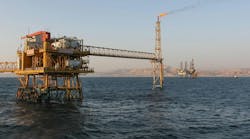ADIPEC 2025: OEG exec details offshore logistics strategy in GCC countries of the Middle East
By Ariana Hurtado, Editor-in-Chief
This week at the ADIPEC Exhibition and Conference in Abu Dhabi, Offshore caught up with Chris Kleinhans, regional director for the Middle East at OEG, to discuss the company’s evolving role in the region’s offshore energy sector. The conversation comes on the heels of OEG’s recent announcement to expand its footprint in Saudi Arabia and Kuwait.
Kleinhans also shared insights into the market forces shaping offshore logistics, the company’s recent equipment investments and how OEG is aligning its services with the Middle East’s long-term energy transition goals.
Offshore: What market dynamics and offshore operational challenges are driving OEG’s recent investment and expansion across Qatar, the UAE, Saudi Arabia and Kuwait?
Kleinhans: OEG’s recent investment and expansion across Qatar, the UAE, Saudi Arabia and Kuwait are driven by the Middle East’s accelerating offshore energy development and growing demand for high-integrity, certified offshore assets. Qatar, in particular, has become one of OEG’s strongest growth markets, contributing more than one-third of the region’s revenue and delivering three consecutive years of double-digit growth.
This expansion is underpinned by rising offshore exploration and production activity, which requires reliable asset rental support. At the same time, increased standards in safety and compliance have made DNV 2.7-1 certified assets a key differentiator. OEG’s regional localization strategy, including partnerships such as Venture Gulf Engineering, ensures operational continuity and responsiveness, helping the company meet escalating technical and safety expectations across multiple Gulf states. Operationally, OEG continues to navigate challenges such as maintaining uptime, asset performance and deployment efficiency, all while delivering consistently high service standards in demanding offshore environments.
Offshore: How does OEG’s US$6 million equipment investment reflect evolving fleet requirements for offshore operations in the Middle East’s harsh environments?
Kleinhans: OEG’s US$6 million fleet investment demonstrates its commitment to building one of the most modern and advanced offshore equipment fleets in the Middle East. This funding supports approximately 700 new units, more than half of which are deployed in Qatar, purpose-built for high-temperature, corrosive and logistically complex environments.
The investment reflects a shift in fleet requirements toward durability and modularity, enabling efficient logistics and redeployment. It also highlights enhanced design integrity and performance certification under DNV 2.7-1 standards, as well as the integration of smart, safety-enhanced systems. Drawing on the group’s engineering expertise from the UK, OEG ensures technical uniformity and reliability across its regional operations.
Offshore: How is OEG positioning itself as a long-term logistics partner for sustainable offshore energy projects in the Middle East?
Kleinhans: OEG is positioning itself as a strategic logistics and offshore services partner for sustainable offshore energy projects across the Middle East through multi-year contracts that provide operational continuity for major exploration, production and service companies. The company’s localized execution, supported by global technical expertise, ensures both responsiveness and regulatory compliance.
Collaborations with local partners, such as Venture Gulf Engineering, further strengthen OEG’s commitment to sustainable, in-country value creation. This long-term approach aligns closely with the Middle East’s wider energy strategy, particularly as the region advances in LNG production and low-carbon infrastructure initiatives.
Containerized offshore logistics
About a year ago, OEG opened a new facility in the Middle East, offering cargo carrying unit rentals in Saudi Arabia, Qatar, Kuwait and the United Arab Emirates (UAE).
Source: OEG - YouTube
Offshore: What lessons from OEG’s regional growth could be applied to other offshore markets undergoing energy transition or infrastructure modernization?
Kleinhans: OEG’s growth in the Middle East offers valuable lessons for other offshore markets undergoing energy transition or infrastructure modernization. It demonstrates that localized partnerships are critical to achieving both market access and sustainable growth. Ring-fenced investment strategies can enable international expansion without diverting resources from core regions such as the North Sea, while cross-regional technical integration reinforces brand consistency and safety standards.
Moreover, fleet modernization, tailored to evolving environmental and operational requirements, enhances competitiveness and positions companies to meet the changing demands of global offshore energy markets.
Offshore: Looking ahead to 2026 and beyond, what fleet innovations or service enhancements is OEG prioritizing to support next-generation offshore energy projects?
Kleinhans: OEG plans to prioritize the development of smart fleet technologies that incorporate digital monitoring, remote diagnostics and advanced data analytics. The company is also focusing on sustainable materials and modular design innovations to reduce environmental impact, alongside upgraded workspace and accommodation modules built to A60 safety standards with enhanced automation and efficiency.
Regional fleet expansion will continue to support next-generation offshore energy projects, especially those aligned with energy transition objectives. OEG’s continued additive capital approach, expanding its Gulf presence without compromising commitments in the North Sea, reflects its confidence in achieving parallel growth across both mature and emerging offshore markets.
OEG is exhibiting at booth 12115 in Hall 12 at the ADIPEC Exhibition and Conference, which has been taking place this week in Abu Dhabi, UAE.
*Offshore is a media partner of ADIPEC 2025.
About the Author
Ariana Hurtado
Editor-in-Chief
With more than a decade of copy editing, project management and journalism experience, Ariana Hurtado is a seasoned managing editor born and raised in the energy capital of the world—Houston, Texas. She currently serves as editor-in-chief of Offshore, overseeing the editorial team, its content and the brand's growth from a digital perspective.
Utilizing her editorial expertise, she manages digital media for the Offshore team. She also helps create and oversee new special industry reports and revolutionizes existing supplements, while also contributing content to Offshore's magazine, newsletters and website as a copy editor and writer.
Prior to her current role, she served as Offshore's editor and director of special reports from April 2022 to December 2024. Before joining Offshore, she served as senior managing editor of publications with Hart Energy. Prior to her nearly nine years with Hart, she worked on the copy desk as a news editor at the Houston Chronicle.
She graduated magna cum laude with a bachelor's degree in journalism from the University of Houston.



